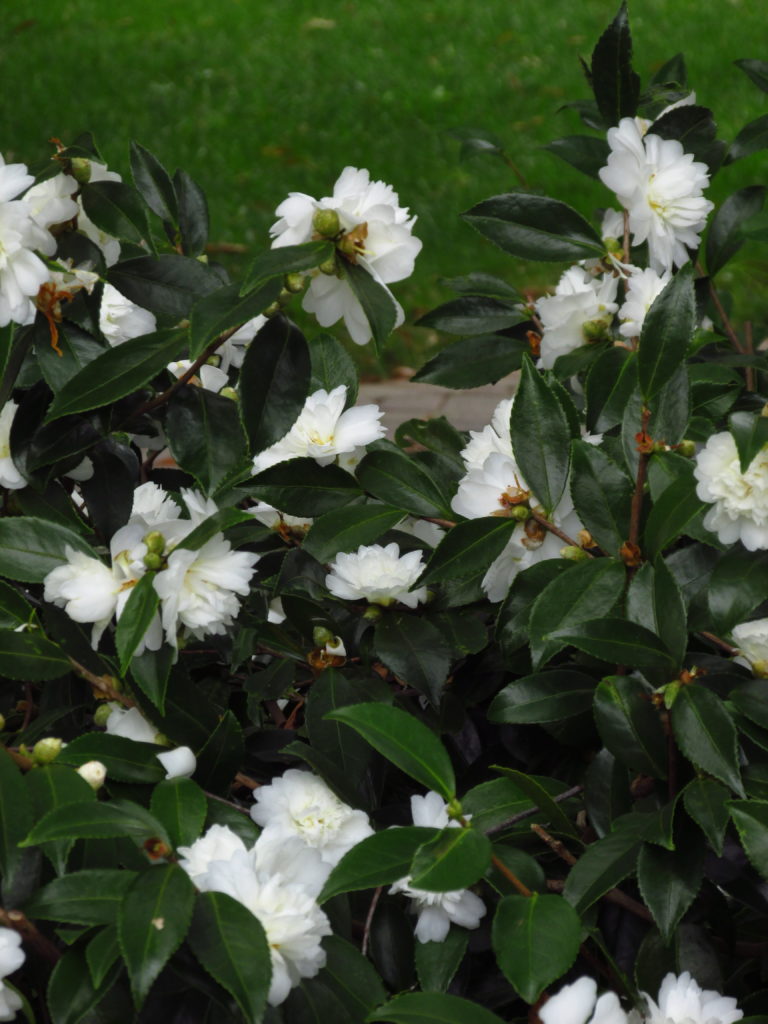
Winter is the perfect time to look at your landscape with fresh eyes. If you have shrubs flanking your front door, or along your sidewalk, that are in need of an update, consider tackling this project while temperatures are cool, from January through March. In the South, planting shrubs in cool weather is a good strategy. Woody plants that are allowed to settle in during cool weather tend to have less summer stress.
First, do your homework.
Before you dash to the garden center to buy new plants, study the area in question. Are there windows that have been blocked by tall growing plants? Do you want a little height at the corners of your house? Would you like to include shrubs with flowers? Are you open to plants that will lose their leaves in the winter, or do you prefer evergreen shrubs?
Next, visit your local botanical garden (or garden center) so that you can make a list of shrubs you like. Both are excellent places to explore, take photos, and jot down information. Then, do a little research before you buy, and find out the mature size of any plants you’ve listed as potential purchases. Plant tags typically provide this information, but you may want to take the extra step to look at a few websites to get more detailed information. A tag may indicate that the shrub in question will grow to maturity to approximately 4 ft. x 5 ft. Sometimes these descriptions are accurate and sometimes they can be misleading. Plant growth rates can also be taken into consideration. Slow-growing plants with a horizontal form, such as prostrate yew, are desirable in areas where you want to keep things low, such as under windows.
Why does size matter?
The reason that you see so many shrubs around town that have been pruned into meatball shapes, is that the mature size of the plant was not considered when plant choices were made. That burford holly planted next to your front door will grow into a very large shrub over time, even if you prune it regularly.
Do you want to spend your weekends trimming shrubs into balls to keep them from overgrowing their space? If using gas-powered lawn tools all summer long is not your hobby, consider your options.
While the classic boxwood is a wonderful shrub that can be used in many ways–to give structure and organization to garden spaces, or as part of an elegant container planting, there are many interesting options that can take you beyond the clipped boxwood ball.
For an area in morning sun and afternoon shade (or dappled sun), try the fall-blooming Camellia sasanqua, a slow grower. Choose an upright vase-shaped variety such as ‘Kanjiro’ or a horizontal grower, such as ‘Bonanza’. Other options for these light conditions are pieris, oakleaf hydrangea ‘Pee Wee’, prostrate yew, and loropetalum ‘Snow Emerald’.
If you want height over time, perhaps to frame the corner of your house, instead of choosing a tree, which will overgrow the space in a decade or less, try a spring-blooming Camellia japonica, perfect for part shade. Another good option, for a larger space, is distylium, a plant that has been on the market for a few years now, which has a graceful horizontal form. This plant will take up quite a bit of horizontal space, unless you prune it regularly, so choose the named variety carefully to get the size you want.
For sunny areas, consider one of the abelia varieties such as ‘Twist of Lime’ or ‘Canyon Creek’. While some people trim these plants into loose balls, they are at their most graceful when you allow the arching branches to expand all Summer, when they will be covered with tiny blooms. (Hummingbirds and butterflies will flock to them.) You can cut back entire branches from time to time during the season, or wait until late winter to cut them back to the ground, allowing new growth to emerge in Spring.
One of the most popular shrubs for the southern landscape is the sun-tolerant panicle hydrangea ‘Limelight’ and its smaller cousin ‘Little Lime’. Both are invaluable in the summer garden, and if you plan carefully, they can certainly be added to your landscape. Both bloom on new growth, and are typically cut down to a foot or less in late winter, which also controls their size. ‘Limelight’ is best used at the corner of a house or in an open space, while ‘Little Lime’, can easily be used as part of a mixed border along a sidewalk.
If you don’t require your shrubs to have evergreen foliage, try a dwarf variety of flowering quince for lovely, early spring blooms or weigela ‘Sonic Bloom’ for spectacular summer blooms.
All of these shrubs can certainly be planted in spring, but I hope you’ll use the winter months to flex your creative muscle, and get a head start on garden projects.